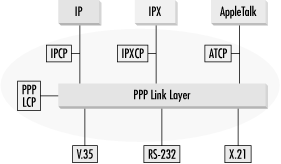Everything secret degenerates; nothing is safe that does not bear discussion and publicity.
HDLC, as specified by ISO, falls short of the Platonic ideal of a generic link layer protocol. It cannot multiplex higher-layer network protocols; cannot detect faults, slowly degrading links, or looped-back links; and is not easily extensible or dynamically configurable. Even after Cisco’s extensions to HDLC, many of these problems remained unsolved.
To address these shortcomings, the IETF developed the Point-to-Point Protocol (PPP). PPP framing is based on HDLC, but it was designed from the outset to be a multiprotocol link layer. A system of configurable option negotiation allows both ends of a link to choose a mutually compatible set of configuration parameters, even if the configuration differs between the two ends of the link. PPP’s negotiation mechanism allows for easy extensibility, a feature that has been exploited by several minor revisions to the protocol after its most recent major standardization in 1994. Well-designed protocols can provide a framework for generations, and PPP has adapted nearly effortlessly to the sea of changes in the Internet since 1994.
A great deal of PPP’s success stems from the solid foundation of HDLC on which it was built, but its innovations add tremendous flexibility. PPP can be used on everything from the high-speed SONET links at the core of the Internet to the lowly dial-up links connecting subscribers over common telephone lines. This chapter describes PPP’s major architectural features, with special regard to how they apply to T1 links. As a result, this chapter does not pretend to be a definitive work on PPP. Features that are common and practically necessary on dial-up links (asynchronous HDLC, the octet-stuffed interface, authentication, and the different types of compression) are not described at all. See Appendix F for further reading.
PPP is familiar to most Internet users as the standard method of establishing a dial-up connection to an Internet service provider. PPP is far more than an enabler of dial-up connections, though, which is why its presence is required on all IPv4 routers with serial interfaces.[16] PPP is specified in RFC 1661, and critical framing information is found in RFC 1662. Appendix F lists complete reference information.
Taken together, these two RFCs provide the basic elements needed to move packets from one end of a serial link to another. Three basic components come together to make it all happen:
- Encapsulation and framing
To multiplex several protocols across a network link simultaneously, PPP defines a link layer header that includes a protocol type field. PPP frames are derived from HDLC frames and provide a byte-oriented logical interface to bit-oriented serial hardware. After a link is established, data frames of various protocols coexist with link-management traffic.
- Link management and monitoring
This is accomplished through the use of PPP’s Link Control Protocol (LCP). PPP may be used with circuit-switched connections such as dial-up or ISDN as well as with dedicated leased lines. Circuit-switched connections often incur charges based on usage, so PPP includes a way to bring up and tear down the physical link. After the link is established, users may wish to monitor the quality of the link to ensure that it is able to cope with the demands placed on it, so PPP includes a link-monitoring mechanism.
- Network-protocol management
Many different network protocols may peacefully coexist on a PPP link. Each network protocol must define an associated Network Control Protocol (NCP) to manage and assign network layer addresses and to terminate idle network connections. Most PPP links carry IP, though not necessarily exclusively, so the Internet Protocol Control Protocol (IPCP) is an important component of PPP links.
PPP provides a generic link layer that can be used for several different network protocols. Figure 9-1 shows how PPP and its control protocols fit into the protocol stack.
High-speed leased lines present a different environment from low-speed, asynchronous links. Asynchronous links usually require the use of header-compression techniques for bandwidth efficiency, as well as an asynchronous control character map (ACCM) to avoid interpreting data as commands for the communicating equipment. Synchronous leased lines do not require special treatment, so the ACCM is not used. On leased lines, however, speed is usually high, so the router CPU load of compressing PPP headers is too great on high-speed links. When asynchronous links fail, the modems disconnect. Synchronous serial links may fail in obscure ways, as discussed in prior chapters, which means that link monitoring is an important feature for detecting problems. Both high-speed and low-speed asynchronous links typically use magic numbers to detect looped-back conditions. Arguably, use of magic numbers is more important on high-speed links because leased lines are much easier to accidentally loop back.
[16] RFC 1812, since updated by RFC 2644, documents the requirements for IPv4 routers. That is, of course, not to imply that all routers follow the requirements religiously...

